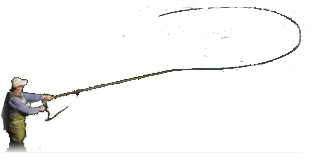Weekly Fraser Valley Sport Fishing Column and Report
Weekly Fraser Valley Sport Fishing Column for Jan 25 to Feb 1, 2016
Those of us familiar with the classic film, ?A River Runs Through It,? can recall this exchange between the Mclean brothers.
Paul yells across the river, ?What are they biting on?
Norman yells back, ?Louder!?
?I said?
Norman replies, ?Bunyan Bugs! Want me to bring you one?
?No! I?ll come get it.?
Norman hands Paul a fly saying, ?Bunyan Bug, Stone fly Number two.?
Paul replies, ?Thank you, merciful professor of poetry and trout.?
Roll the clock back to 1909, when a ten year old boy, named Norman Edward Lee Means, living in the hills of West Virginia, is experimenting with his own dry fly designs. Twelve years later in 1921 Norman Means is studying forestry at the University of Montana. There in Montana he spends most of his spare time fishing local rivers, such as Rock Creek and the Blackfoot. He becomes a professional forester and earns the nick name ?Paul Bunyan.? In 1927 he is selling his flies locally and lays the ground work for the Paul Bunyan?s Fishing Tackle Company, offering thirty five specific fly patterns. Two years further down the road Means achieves national recognition in 1929, when an aspiring young writer from Michigan, named Enos Bradner, writes an article about Bunyan and his bugs, for Forest and Stream magazine.
The crowning glory of the Bunyan Bugs was Norman?s stonefly; which he formed from a hollowed out, cylinder shaped, cork body he cut himself. Next the fly body was finished by varnishing stencil designed tissue paper to it. Horse mane was used for the wings and the hook size was either #4 or #2.
Norman Edward Lee (Paul Bunyan) Means; died twelve years short of seeing his Bunyan Bug Stonefly #2, achieve Hollywood fame in the movie ?A River Runs Through It,? but he did see his fly immortalized in Norman McLean?s bestselling novel of the same name.
?Eventually, all things merge into one, and a river runs through it. The river was cut from the world?s great flood, and runs over rocks from the basement of time. On some of those rocks are timeless raindrops. Under the rocks are words, and some of the words are theirs.? Norman Mclean, A River Runs Through It.
The Report
Our lower mainland lakes are fishing fair to good. Try: Chironomid, Bloodworm, Wooly Bugger, Doc Spratley, Halfback, Micro Leach, Pumpkinhead, or Baggy Shrimp. For ice fishing at our higher elevation lakes, try: Shrimp, Baggy Shrimp, Ice Flies, and Crappie Jigs.
The Fraser River along with its backwaters and sloughs are fishing well for whitefish, cutthroat, rainbow, dolly Varden, and early steelhead. For cutthroat try: Rolled Muddler, Flesh Fly, Eggo, Professor, Silver Doctor, Borden Special, Zulu, or small black Stone Nymph. For dolly varden try: large Clouser?s Deep Minnow. Zonker, Eggo, Flesh Fly, Dolly Whacker, or Kauffman Stone. For rainbow try: Czech nymph, Cased Caddis, Coachman, Rolled Muddler, Mico Leach, or Zulu. For whitefish try: Czech Nymph, Cased Caddis, Eggo, Hairs Ear nymph, or Mico Leach. For steelhead try: Big Black, Flat Black, Squamish Poacher, Polar Shrimp, Popsicle, GP, Steelhead Nightmare, or Kauffman Stone.
The Stave River is good for Whitefish, steelhead, rainbow, and cutthroat.
The Harrison River is good for cutthroat and rainbow.
The Vedder River is good for rainbow and steelhead.
